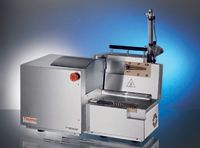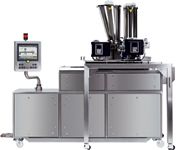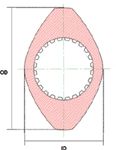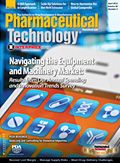Scale-up Challenges in Hot-Melt Extrusion
Critical issues that should be considered when scaling up a hot-melt extrusion process.
Hot-melt extrusion (HME) using twin-screw extruders (TSEs) is increasingly being used to make solid dispersions of drugs in a polymer matrix. The process is useful for poorly soluble drugs and for alternative dosage forms such as controlled-release drug devices. Small, benchtop TSEs are available for formulation development, but these are typically not appropriate for process development. Mid-size TSEs, however, can be used for process development and scale-up.

Jennifer Markarian
Benchtop TSEs
In the past, laboratories had only small-scale batch mixers for formulation development, but during the past few years, several extruder manufacturers have introduced laboratory-scale TSEs suitable for API quantities as small as 5–20 g, thus enabling pharmaceutical manufacturers to test new drug candidates on a TSE.
A TSE has shorter residence time and exposes the material to lower thermal stress than a small-scale batch mixer, notes Andrew Loxley, director of new technologies at Particle Sciences, a company providing drug-development services. Particle Sciences uses either a small-scale, batch mixer or a benchtop, laboratory-scale TSE (MiniLab, Thermo Scientific), as shown in Figure 1, to prepare proof-of-concept materials and identifyearly-lead formulations before running process experiments on a 12-mm or 18-mm mid-size extruder at rates from 1–15 kg/h. While benchtop extruders are useful as a screening tool, they do not scale up to larger-volume extruders because equipment-design attributes are fundamentally different.

Figure 1: An example of a benchtop, twin-screw extruder (MiniLab, Thermo Scientific). (FIGURE 1 COURTESY OF THERMO SCIENTIFIC.)
Mid-size TSEs
Mid-size extruders in the range of 12–20 mm in diameter that have similar design attributes to larger extruders can be used for process development in preparation for scale-up to pilot-size or small commercial-size TSE in the range of 26–32 mm and perhaps eventually to larger commercial-size TSE in the range of 40–70 mm. Extruder manufacturers, such as Coperion, C.W. Brabender, Leistritz, Steer America, and Thermo Scientific, offer extruders for the pharmaceutical industry in the mid-size range that can be used for process development and clinical-scale trials as well as small-scale commercial runs. In some cases, drug manufacturers may even choose to use these mid-size extruders for commercial production.
Throughputs on Coperion's 18-mm ZSK, for example, range from 500 g/h to 4 kg/h, with a minimum batch size of 1 kg (see Figure 2). CDMO Bend Research uses an 18-mm extruder that runs up to 3 kg/h and has run batch sizes as small as 300 g. Bend Research has scaled up from an 18-mm extruder to throughputs as high as 10 kg/h on its 27-mm extruder, and from a 27-mm to a 50-mm extruder, all of which have similar equipment attributes. Brabender's 12-mm TSE runs batches in the 25–100 g range for product and process development, up to 1.5 kg maximum. The 12-mm scales up to Brabender's 20-mm TSE, which can be used for further process development.

Figure 2: An example of a mid-size extruder (ZSK 18 MEGAlab with 18 mm screw diameter and mobile feeding unit, Coperion GmbH). (FIGURE 2 COURTESY OF COPERION GMBH)
Mid-size extruders are useful for determining the "extrudability" of a formulation and identifying the extrusion conditions needed for good mixing, says Stefan Gebhardt, head of extrusion systems for pharma and food at Coperion. Parameters can include the extruder's screw design, temperature profile, shear rate, and throughput.
The processing window for pharmaceutical excipients is narrow, and in some cases, a few degrees in temperature change can have a dramatic affect on material viscosity, says Gebhardt. In addition, excipients and APIs may be sensitive to degradation from heat or shear.
Determining the appropriate temperature profile in a TSE, therefore, is an important parameter in running process experiments. In the processing laboratory, researchers may want to run multiple temperature profiles in a short period of time and without shutting down the extruder to minimize the amount of experimental material needed. To enable this approach, Coperion recently developed an improved temperature-control system using cartridge heaters and a water-cooling system that allows its mid-size extruder to reach stable temperature conditions more quickly.
Processing laboratories also have a need to be able to quickly clean the screw or change the screw profiles of an extruder between experiments. Several mid-size extruders have a clamshell barrel design in which the barrel cover opens on a hinge to allow easy access for cleaning and screw changes.
Scale-up considerations
Scale-up in a continuous process from a mid-size to a larger size TSE is actually much more predictable than scale-up of batch mixing, says Gebhardt. Extrusion mixing is more repeatable than batch mixing because the shorter mass transfer inherent with the design of a TSE allows materials to be intimatelymixed, adds Charlie Martin, president of Leistritz.
"In a TSE, the processor must manage residence time distribution using screw design, screw speed (rpm), and degree of screw fill," explains Martin. Matt Shaffer, senior research engineer at Bend Research, adds that to successfully scale up to a larger TSE, the processor should understand how the boundary conditions and process parameters at the smaller scale relate to the quality attributes of the product.
In general, to scale up well, the basic geometry of the smaller extruder should match that of the larger extruder. The ratio of the outer diameter (OD) to the inner diameter (ID) of the screw, as shown in Figure 3, is a key parameter. The Coperion 18-mm extruder, for example, has the same OD/ID ratio of 1.55 that is found on the larger Coperion extruders.

Figure 3: The outer diameter (OD) to inner diameter (ID) of the screw is a key parameter. (FIGURES 3 AND 4 COURTESY OF LEISTRITZ)
The screw elements of a TSE (i.e. feeding, conveying, melting, mixing, venting, and pumping) are modular and can be easily changed to optimize the screw profile (see Figure 4). In scale-up, the screw profile of the larger extruder should be similar to that of the smaller extruder. A similar profile is only a starting point, however, because adjustments are often needed, notes Gebhardt. Shaffer adds that mass- or heat-transfer limitations can arise at larger scales, therby affecting dispersion and uniformity. "These competing limits can result in lower throughput increases than would be expected theoretically, and require the use of longer process sections, alternative screw designs, or lower screw speeds, which can in turn alter the residence time distribution of the material within the extruder," he explains.

Figure 4: A set of intermeshing twin screws shows various screw elements.
In addition, the tip speed of the rotating screw flights increases as the screw diameter increases, thereby raising the peak shear to which the material is exposed. Processors should aim to maintain peak shear rates, especially because pharmaceutical ingredients are often temperature-sensitive, says Martin.
The effects of high peak shear can be reduced with tight tolerances that improve the self-wiping characteristics of a TSE and with specialized mixing element design, adds Robert Roden, technology manager at Steer America.
Design-of-experiment approaches and process models are useful for defining the process space. Software tools can be used as a first approach to calculate probable scale-up conditions. Current software is limited, however, because it requires raw-material data, which can be difficult to calculate for a mixture of components that changes as it changes from a solid to a non-Newtonian fluid, says Gebhardt.
He notes that more robust software tools are being developed. Equipment and software improvements, however, can only go so far. Skilled operators remain essential to successful scale-up. "You still need experienced people who understand the machines to run the physical tests on the line and adjust as needed," emphasizes Gebhardt.
Upstream processes, especially how materials are fed into the extruder, should also be considered during scale-up. In split feeding, the polymeric excipient and the API are fed separately into the extruder, but in a premix the two are combined in a dry blend and fed to the extruder in one stream.
Commercial extrusion uses either split-fed or premixed feeds, depending on the application. Split-feeding must be used when feeding different physical forms, such as an excipient in pellet form and an API in powdered form. Premixing performs a percentage of the mixing, but in a split-fed system the extruder does 100% of the mixing, which may lead to decreased rates or less mixing, says Martin.
On the other hand, a split feed in which the API is added part way down the extruder, after the excipient is at least partly melted, is useful for limiting the exposure of sensitive APIs to heat and shear.
Laboratories may use a premix feed because small volumes require specialized feeding equipment to meter accurately. Matching the feeding method of the smaller-scale to that of the larger-scale, however, can be a factor in scaling up the process because the feeding method significantly affects mixing. Dosing equipment suppliers, such as K-Tron and Schenck, offer feeders that that are accurate even at low flow rates for use with mid-size extruders.
Downstream processes, including cooling and pelletizing, are sometimes neglected in development timelines, but should be considered as part of scale-up because these aspects can lead to a bottleneck in the overall process.
Considering upstream and downstream operations as well as an extruder's processing parameters are key to successfully scaling up from a mid-size to larger-size extruder.
Jennifer Markarian is the acting manufacturing editor at Pharmaceutical Technology, 485 Route One South, Building F, First Floor, Iselin, NJ 08830 tel. 732.346.3087, jmarkarian@advanstar.com.
Have an equipment or processing troubleshooting concern? Email it to jmarkarian@advanstar.com and we may address the problem in a future column.

Drug Solutions Podcast: A Closer Look at mRNA in Oncology and Vaccines
April 30th 2024In this episode fo the Drug Solutions Podcast, etherna’s vice-president of Technology and Innovation, Stefaan De Koker, discusses the merits and challenges of using mRNA as the foundation for therapeutics in oncology as well as for vaccines.
Pharmaceutical Tariffs Are Imminent: How Industry is Bracing for Impact
April 16th 2025On April 14, 2025, the Trump Administration launched a national security-driven investigation into pharmaceuticals, a move that will likely result in tariffs being placed on pharmaceutical drugs, ingredients, and other components that are imported from outside of the United States.